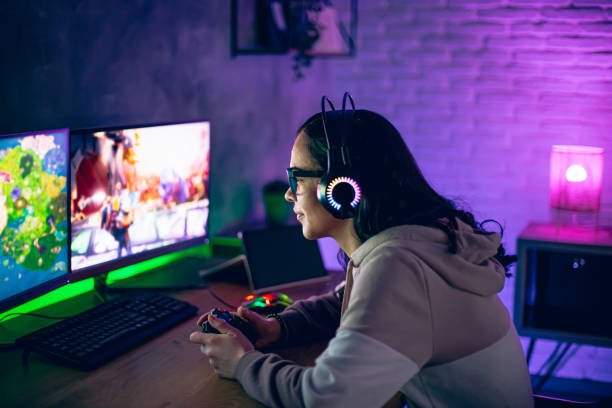It’s the middle of the night, and somewhere in a dimly lit bedroom, a teenager’s face glows blue as digital gunfire echoes through headphones. Fingers dance over a controller, eyes locked on the screen, breaths quickening as virtual enemies swarm. Hours slip by unnoticed, meals go cold on the table, and the real world fades into an electronic fog. Elsewhere, an adult hunches over a smartphone on a crowded subway, chasing bright jewels in a match-three puzzle, swiping, tapping, locked in a private trance. Millions more sit at desks, scouring virtual landscapes in massive online worlds that promise camaraderie, achievement, and escape.
This is not simply entertainment—it is a phenomenon that has swept the globe with unprecedented force. Video games are more addictive than ever before, and behind the flashing screens lies a complex interplay of psychology, neuroscience, technology, and human desire.
For decades, the narrative about video games was quaint: they were hobbies for kids, simple diversions, time-wasters. Now, they stand among the most powerful engines of engagement ever devised. Fortnite earns billions by selling digital costumes. Mobile games like Candy Crush have hooked entire generations on microtransactions. Competitive titles like League of Legends and Valorant have built empires, transforming players into international stars. Even casual games are meticulously engineered to snare attention and keep it captive.
Why have video games become so irresistibly addictive? To answer that question, we must journey into the realms of the human brain, the dark genius of game design, the lure of social validation, and the subtle transformations in modern life that leave so many longing for virtual refuge.
Pixels and Pleasure: The Neuroscience of the Hook
Imagine for a moment that the human brain is a vast city, filled with billions of tiny messengers carrying chemical signals along invisible highways. Deep within this city lies a small region called the nucleus accumbens—the brain’s reward center, often dubbed the pleasure center. This is where desires are born, cravings stoked, and satisfaction delivered.
When we experience something pleasurable—whether it’s chocolate melting on the tongue, a lover’s touch, or a stroke of good luck—the brain floods this region with dopamine. This neurotransmitter acts like a spotlight, telling us: “That felt good. Do it again.”
Video games are dopamine factories.
Every time a player levels up, finds treasure, unlocks a new skill, or defeats an enemy, the brain gets a jolt of dopamine. This system evolved to reward behaviors that kept our ancestors alive—hunting, social bonding, exploring. But in the modern digital landscape, it’s hijacked by virtual victories and digital rewards.
The trick is that dopamine doesn’t merely signal pleasure—it fuels anticipation. It’s the reason gamblers feel euphoric even before the dice roll. It’s the spike of excitement before opening a loot box in a game, or the tension just before winning a battle royale. Game developers know this. They design mechanics—like random rewards, daily login bonuses, and streaks—to keep dopamine flowing.
Even failures are carefully balanced. A game that’s too easy becomes boring. A game that’s too hard leads to frustration and quitting. The sweet spot—the zone psychologists call “flow”—lies in the delicate balance between challenge and skill. When players enter flow, they lose track of time, the world fades away, and only the game remains.
Crafting Compulsion: The Art of Game Design
Modern games are not simply products; they are precision-crafted experiences designed to maximize engagement. Behind every pixelated world lies a legion of designers, behavioral psychologists, and data scientists who meticulously study how to keep players playing.
Consider “variable ratio reinforcement”—a term borrowed from behavioral psychology. It’s the same principle that makes slot machines so addictive. Players don’t know when the next big reward will come, so they keep spinning the reels. In gaming, this manifests as loot boxes, random drops, or rare item spawns. You might open twenty loot boxes with nothing significant, then suddenly hit a jackpot. The unpredictability fuels compulsion.
Moreover, games exploit the principle of “loss aversion.” People fear losing progress more than they desire gains. This is why games introduce mechanics like streaks or daily quests. If you miss a day, your streak resets. You feel compelled to log in, even if you’re no longer enjoying yourself. It’s a psychological leash that binds players to the game.
Social features are another powerful hook. Games tap into humanity’s deepest needs: belonging, competition, status. Players join guilds, form friendships, and compete on leaderboards. They receive praise for achievements, and scorn for failures. In massively multiplayer online games, quitting can feel like letting down an entire team. This emotional bond is the secret sauce behind the longevity of titles like World of Warcraft, which has kept millions enthralled for over two decades.
Every sound, vibration, and color palette is chosen with intent. Even the speed of animations—the flicker of coins, the sparkle of a rare item—triggers microbursts of satisfaction. Developers test hundreds of variations to see which keep players clicking. It’s a craft as meticulous as architecture or film-making, but with the singular goal of ensnaring attention.
The Social Web: Friends, Followers, and FOMO
In the past, games were mostly solitary pursuits. A teenager in the 1980s might play Pac-Man alone in an arcade. Today, games are thriving social networks, blurring the boundaries between entertainment and social media.
Take Fortnite. It’s as much a virtual hangout as a shooter. Teenagers don’t just play the game—they chat, dance, attend virtual concerts, and show off digital outfits. Roblox lets users build worlds and invite friends to explore them. Discord, originally created for gamers, has evolved into a sprawling communication hub where communities gather around games, memes, and friendships.
Social connection magnifies gaming’s addictive pull. We’re wired to seek approval and fear rejection. When friends play together, quitting feels like betrayal. Missing an in-game event means missing out on shared memories. This is FOMO—fear of missing out—and it’s a powerful force.
Some games even incorporate social “pressure loops.” In mobile titles like Clash of Clans, players must contribute resources to their clan. Failing to participate can lead to shame, exclusion, or being kicked out. The stakes are not merely virtual—they touch real emotions.
In online games, relationships form and deepen. Players marry, fall in love, or forge lifelong friendships. To leave a game is to leave a community. For some, their virtual friends are closer than anyone they know offline. And therein lies the paradox: games foster genuine social connection—but they can also become prisons.
The Pandemic Effect
When COVID-19 swept across the globe, billions were confined to their homes. Loneliness surged. Anxieties mounted. The world outside grew frightening and uncertain. Video games became lifelines.
Nintendo’s Animal Crossing: New Horizons sold over 40 million copies in its first year, offering a peaceful island escape from pandemic chaos. Players visited each other’s islands, held virtual weddings, even staged political rallies. Games became therapy sessions, social mixers, and substitutes for travel.
Data shows gaming time spiked during lockdowns. Steam, the popular PC gaming platform, set records for concurrent users. Mobile games saw revenue explode. Parents, desperate for a break, let kids play longer. Adults turned to games to cope with stress.
Yet the pandemic also revealed gaming’s darker side. Mental health professionals reported rising cases of gaming disorder—a recognized diagnosis where gaming interferes with daily life. Some players fell into twenty-hour marathons, neglecting sleep, work, and relationships. For vulnerable individuals, the line between healthy hobby and harmful compulsion blurred.
Economies of Addiction: The Rise of Microtransactions
Once upon a time, you bought a game for a fixed price, played it, and that was the end. Today, games are increasingly “free to play”—but every click is an invitation to spend. Microtransactions are now a multi-billion-dollar juggernaut.
In free-to-play games, progress slows to a crawl unless you pay. Want to skip a twelve-hour wait to build your fortress? Pay a few dollars. Want that powerful sword? Buy a loot box. Want to look cool? Purchase a skin.
Game companies analyze players’ spending habits with forensic precision. They identify “whales”—the small percentage of users who spend thousands. Games are engineered to push these whales gently but relentlessly toward bigger purchases. Psychological tactics abound: time-limited offers, flashy animations, fake currencies that obscure real costs.
This business model has transformed gaming into a platform for constant monetization. The focus is no longer solely on entertainment, but on keeping players engaged—and spending—as long as possible.
Children and teens are particularly vulnerable. Their brains are still developing impulse control. Many rack up huge bills on parents’ credit cards. In some countries, governments have stepped in, regulating loot boxes as gambling.
Yet even adult gamers fall prey. There’s always “just one more pack,” “one more spin,” “one more skin.” It’s not merely a desire for fun—it’s a compulsion fed by carefully crafted scarcity.
Virtual Identities and Digital Prestige
Human beings crave identity. We define ourselves by our clothing, hobbies, possessions, and accomplishments. In the digital realm, video games offer new frontiers for self-expression.
Players meticulously curate avatars. They purchase skins, emotes, custom banners. In games like Fortnite or Call of Duty, a unique skin isn’t just cosmetic—it’s status. It proclaims: I’m skilled, dedicated, wealthy, or connected.
Cosmetics and customization are potent hooks. They transform games from mere entertainment into stages for social theater. Players seek admiration and envy. Entire ecosystems of influencers thrive on showcasing rare items or elite skills, fueling others’ desires to keep playing and spending.
Virtual identities offer something reality sometimes cannot: a chance to become the hero, the conqueror, the star. A shy teenager might be a leader in an online guild. An ordinary worker might become a sniper god in an FPS. These identities become woven into the fabric of who they are.
Yet the cost can be steep. Some players become so invested in their digital personas that they neglect the physical world. Relationships strain. Careers suffer. Sleep evaporates. The virtual world offers constant affirmation, while real life feels mundane by comparison.
Escaping Reality’s Weight
At its core, gaming addiction often stems from a universal human desire: escape. Life can be harsh, disappointing, monotonous. In games, the rules are clear, the goals achievable, the rewards immediate. In the real world, effort often goes unrecognized, and success feels elusive.
For some, games are sanctuaries. A person struggling with depression may find solace in a vibrant digital landscape. A socially anxious teen might blossom in an online guild where nobody knows their face. A stressed adult might find peace slaying monsters instead of facing bills.
Games are safe spaces where players can reinvent themselves, rewrite their stories, and find meaning. Yet the danger lies in when the escape becomes a retreat—a refusal to engage with reality at all.
The World Health Organization classifies gaming disorder as a condition marked by loss of control and prioritization of gaming over other activities, despite negative consequences. Studies show excessive gaming can correlate with anxiety, depression, and loneliness. Yet it’s also true that many people play heavily without harm.
The line is thin and blurry. Gaming, in itself, is not evil. It’s a potent tool for joy, connection, and storytelling. But in a world full of stress and uncertainty, it’s easy for the digital realm to become a velvet trap.
A Generation Growing Up in Game Worlds
Children today grow up surrounded by games from infancy. Tablets, smartphones, consoles—they are born into digital ecosystems engineered for engagement. Companies like Roblox and Fortnite target younger audiences, knowing that loyalty formed in childhood can last decades.
For parents, the challenge is staggering. Games are designed to override natural stopping cues. There’s no “end” to Fortnite or Minecraft. The game flows endlessly, offering new challenges, new seasons, new content. Children throw tantrums when forced to log off because their brains are still learning how to transition between worlds.
Schools struggle with distraction. Children think about games even during class, dreaming of what they’ll build or who they’ll battle. Social hierarchies emerge based on who has the rarest skins or the highest levels.
Yet it’s not all darkness. Games teach teamwork, strategy, creativity, and digital literacy. The key lies in balance. But balance is elusive when every incentive, every notification, every friend’s invitation pushes kids to stay logged in.
The Future: VR, AI, and Ever-Deeper Immersion
We stand at the edge of a new frontier. Virtual reality promises worlds so lifelike, they’ll be indistinguishable from dreams. AI-driven NPCs will converse like real people, blurring reality further. Game worlds will evolve dynamically, learning each player’s preferences.
Imagine logging into a game that adapts its narrative around your emotions, your choices, your friendships. Imagine haptic suits that let you feel every blow, every breeze. The technology is coming—and with it, the potential for even deeper addiction.
Some researchers warn that as games become more immersive, the line between virtual and real will dissolve entirely. Already, VR studies show users experience real fear, real joy, and real pain in simulated environments. For some, these worlds will be irresistible havens. For others, they may become gilded cages.
Hope, Healing, and The Human Spirit
Amidst all the warnings, it’s vital to remember that video games are not inherently evil. They are astonishing feats of creativity, engineering, and art. They tell stories that move hearts, build friendships across continents, and help people find courage and joy.
Millions play without falling into addiction. For some, games are therapeutic tools. They relieve chronic pain, train the brain, and fight loneliness. Esports provide career paths. Game development fuels entire economies. Gaming is not going away—it’s becoming more central to culture, commerce, and human connection.
The challenge for society is nuanced. We must recognize the power of games to enchant and to enslave. We must protect vulnerable players, especially children. We must cultivate awareness and digital literacy, teaching people to recognize when play turns into compulsion.
Above all, we must remember that behind every screen is a human soul, searching for meaning, joy, and connection. It is that yearning—not simply technology—that makes video games so powerful.
The Game Goes On
As dawn approaches, the teenager in the glowing bedroom finally logs off. The subway rider puts away the phone as the train screeches into the station. Across the world, billions of pixels flicker into darkness—until the next session begins.
Video games are more addictive than ever, because they speak to something timeless within us: the hunger for challenge, for connection, for triumph, for escape. They are both art and architecture, dreamscape and snare.
The story of gaming addiction is ultimately a story about humanity itself. We build worlds—and sometimes, we lose ourselves in them. The key lies not in rejecting those worlds, but in learning how to journey through them without surrendering who we are.
Because the game, as they say, always goes on.






